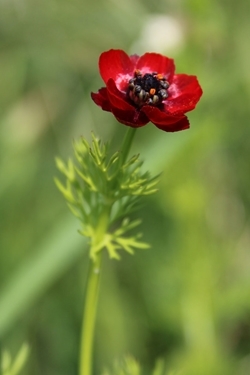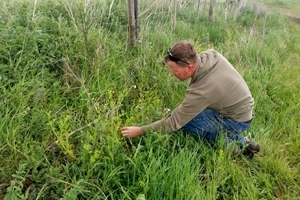Pheasant’s-eye
 Some people might think plants are boring and find it quite strange that I get excited over spotting a plant that I haven’t seen before or watching the season change and seeing a carpet of bluebells appear, but I would argue that there is beauty in everything, and I find plants fascinating. This species of the month is especially special, beautiful, and actually quite rare: the pheasant’s-eye (Adonis annua).
Some people might think plants are boring and find it quite strange that I get excited over spotting a plant that I haven’t seen before or watching the season change and seeing a carpet of bluebells appear, but I would argue that there is beauty in everything, and I find plants fascinating. This species of the month is especially special, beautiful, and actually quite rare: the pheasant’s-eye (Adonis annua).
As always, I like to know about the mythology and folklores connected to species and this one has quite an interesting story. The genus that pheasant’s-eye belongs to is named after Adonis, who, according to Greek mythology, was a handsome young man loved by the goddess Aphrodite. He was killed by a wild boar, causing Aphrodite great sadness and according to legend, bright red flowers sprang from the drops of Adonis’ blood rather than from Aphrodite’s tears.
Pheasant’s-eye is a stunning scarlet blood red flower with lime green bright leaves, an unlikely looking member of the buttercup family, it has flowers resembling those of anemones, and if you read this regularly you will know how much I love a wood anemone. The central part of the flower has black anthers and a dark spot at the base of each petal, and it grows up to 50cm in height and can be much branched. The leaves are deeply divided giving a feathery appearance and the flowers are 15-25mm wide. It has elongated oval seed heads that bear approximately 30 olive green seeds, similar in shape to a grape pip. This is quite a description, but this plant is unmistakable when flowering and it will catch your eye – it took my breath away. However, beware: the young plants do look similar to species of mayweed, so you might have to have a closer look to be sure what you have.
Pheasant’s-eye is an annual herb, an arable plant species, typically found in calcareous soil field margins and corners of autumn (and sometimes spring) sown cereal fields, but also can be found on areas of regularly disturbed grassland, such as Salisbury Plain. It flowers from June to July, but this year it flowered much earlier at the start of May. It mainly germinates in the autumn, but it can also germinate in spring crops and can have extremely short-lived seed, possibly just six months, but in the right soil seeds can remain viable for much longer.
The reason that this species is so important is because there are approximately 20 sites in the whole country that have pheasant’s-eye now, holding the GB status as Endangered.
There are several factors for its decline, seed cleaning being one of the main ones, as historically the large seeds of pheasant’s-eye were spread within cereal seed. It is also a poor competitor, preferring open vegetation, low soil nutrient levels and regular cultivation, and the threats of intensive farming, particularly the development of competitive cereal crop varieties that grow quickly, closing the cereal sward, prevents light reaching the seedlings so they die before they have chance to flower. But the last factor is the widespread use of broad-spectrum herbicides, which has also had a negative effect on this species.
It is hard to believe that in the 18th century this flower was picked in great numbers and sold as a cut flower called the “Moroccan red”!
This might all sound all doom and gloom, but there is a light at the end!
 I am very privileged in my job that I work with two groups of inspirational farmers, gamekeepers, graziers, foresters and estate managers within the two Farmer Clusters I am the Facilitator for (Allenford and Martin Down). Last year, an area of vegetation was cleared on the verge next to an arable field by one of the gamekeepers in the Farmer Cluster, and when he returned he noticed a lone pheasant’s-eye had appeared, which was astonishing. The keeper and farm manager then cleared the rest of the area that winter, removing the topsoil and scratching it up with a digger, and from that one lone plant, we counted approximately 52 individual plants this summer!
I am very privileged in my job that I work with two groups of inspirational farmers, gamekeepers, graziers, foresters and estate managers within the two Farmer Clusters I am the Facilitator for (Allenford and Martin Down). Last year, an area of vegetation was cleared on the verge next to an arable field by one of the gamekeepers in the Farmer Cluster, and when he returned he noticed a lone pheasant’s-eye had appeared, which was astonishing. The keeper and farm manager then cleared the rest of the area that winter, removing the topsoil and scratching it up with a digger, and from that one lone plant, we counted approximately 52 individual plants this summer!
Such a success and such a sight to see – especially as it was the first time I had seen this plant, and not many people can say they have seen one, let alone 50-odd plants! We have also found it growing on other farms in the Farmer Cluster and we have collected seed and will be managing new areas to increase its range. So, this Species of the Month is dedicated to the hard work and commitment of those in the Farmer Cluster who are working hard to safeguard this species in this area and beyond, as some of the seed we collected will be stored at the Millennium Seedbank!
Megan Lock
Advisory